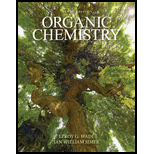
(a)
To determine: The major product that is formed by reaction of benzene with
Interpretation: The major product that is formed by reaction of benzene with
Concept introduction: Friedel-Crafts alkylation permits the synthesis of alkylated products by the reaction of arenes with alkyl chlorides in the presence of aluminium chloride (Lewis acid). This alkylation reaction comes under the category of electrophilic aromatic substitution.
(a)
Answer to Problem 17.50SP
The major product that is formed by reaction of benzene with
Explanation of Solution
The major product that is formed by reaction of benzene with
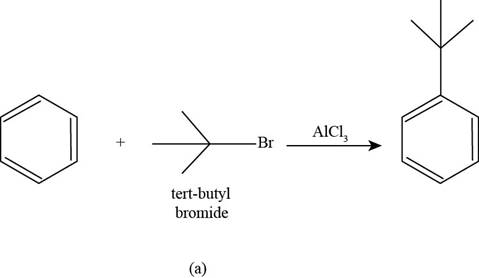
Figure
In the above reaction, benzene reacts with
(b)
To determine: The major product that is formed by reaction of benzene with
Interpretation: The major product that is formed by reaction of benzene with
Concept introduction: Friedel-Crafts alkylation permits the synthesis of alkylated products by the reaction of arenes with alkyl chlorides in the presence of aluminium chloride (Lewis acid). This alkylation reaction comes under the category of electrophilic aromatic substitution.
(b)
Answer to Problem 17.50SP
The major product that is formed by reaction of benzene with
Explanation of Solution
The major product that is formed by reaction of benzene with
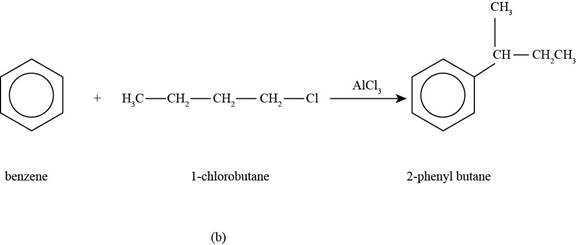
Figure
In the above reaction, benzene reacts with
(c)
To determine: The major product that is formed by reaction of benzene with isobutyl alcohol in the presence of
Interpretation: The major product that is formed by reaction of benzene with isobutyl alcohol in the presence of
Concept introduction: Friedel-Crafts alkylation permits the synthesis of alkylated products by the reaction of arenes with alcohol in the presence of
(c)
Answer to Problem 17.50SP
The major product that is formed by reaction of benzene with isobutyl alcohol in the presence of
Explanation of Solution
The major product that is formed by reaction of benzene with isobutyl alcohol in the presence of
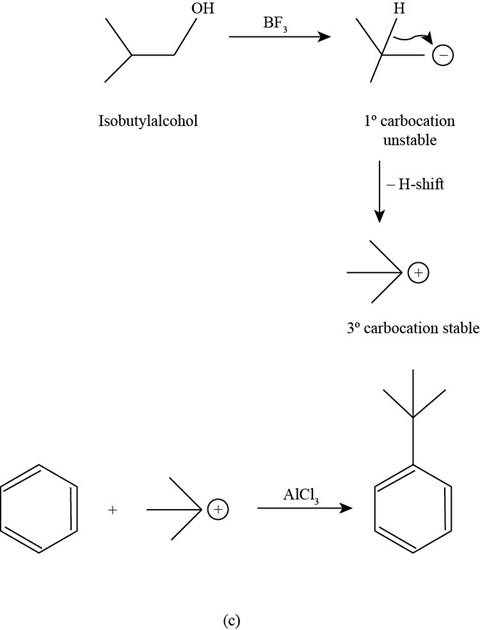
Figure
In the above reaction, the primary carbocation that is generated by the protonation of isobutyl alcohol by
In the second step, this electrophilic carbocation reacts with benzene in the presence of
(d)
To determine: The major product that is formed by reaction of benzene with bromine in the presence of a nail.
Interpretation: The major product that is formed by reaction of benzene with bromine in the presence of a nail is to be predicted.
Concept introduction: The reaction that includes the addition of one or more bromine atoms in a compound is known as bromination reaction. Bromination reaction is a type of halogenation reaction.
(d)
Answer to Problem 17.50SP
The major product that is formed by reaction of benzene with bromine in the presence of a nail is shown as follows.
Explanation of Solution
The major product that is formed by reaction of benzene with bromine in the presence of a nail is shown in Figure
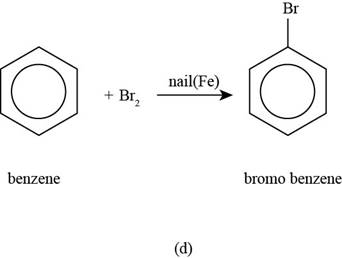
Figure
In the above reaction, bromination of benzene ring occurs to form bromobenzene as the desired product.
(e)
To determine: The major product that is formed by reaction of benzene with isobutylene in the presence of
Interpretation: The major product that is formed by reaction of benzene with isobutylene in the presence of
Concept introduction: Friedel-Crafts alkylation permits the synthesis of alkylated products by the reaction of arenes with
(e)
Answer to Problem 17.50SP
The major product that is formed by reaction of benzene with isobutylene in the presence of
Explanation of Solution
The major product that is formed by reaction of benzene with isobutylene in the presence of
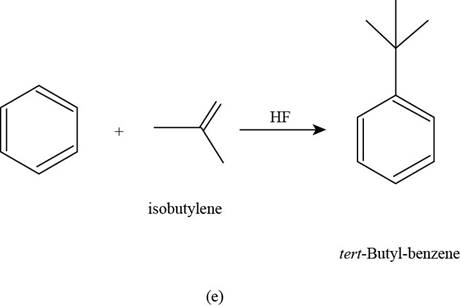
Figure
In the above reaction, benzene reacts with isobutylene in the presence of
(f)
To determine: The major product that is formed by reaction of benzene with fuming sulphuric acid.
Interpretation: The major product that is formed by reaction of benzene with fuming sulphuric acid is to be predicted.
Concept introduction: The process of attaching
(f)
Answer to Problem 17.50SP
The major product that is formed by reaction of benzene with fuming sulphuric acid is shown as follows.
Explanation of Solution
The major product that is formed by reaction of benzene with fuming sulphuric acid is shown in Figure

Figure
In the above reaction, benzene reacts with fuming sulphuric acid to form as the desired sulfonated product.
(g)
To determine: The major product that is formed by reaction of benzene with
Interpretation: The major product that is formed by reaction of benzene with
Concept introduction: Friedel-Crafts alkylation permits the synthesis of alkylated products by the reaction of arenes with alkyl chlorides in the presence of aluminium chloride (Lewis acid). This alkylation reaction comes under the category of electrophilic aromatic substitution.
(g)
Answer to Problem 17.50SP
The major product that is formed by reaction of benzene with
Explanation of Solution
The major product that is formed by reaction of benzene with
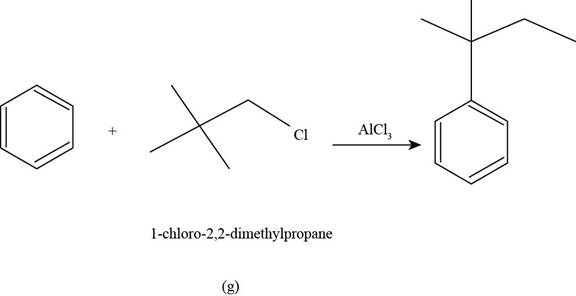
Figure
In the above reaction, benzene reacts with
(h)
To determine: The major product that is formed by reaction of benzene with benzoyl chloride in the presence of
Interpretation: The major product that is formed by reaction of benzene with benzoyl chloride in the presence of
Concept introduction: Friedel-Crafts alkylation permits the synthesis of alkylated products by the reaction of arenes with alkyl chlorides in the presence of aluminium chloride (Lewis acid). This alkylation reaction comes under the category of electrophilic aromatic substitution.
(h)
Answer to Problem 17.50SP
The major product that is formed by reaction of benzene with benzoyl chloride in the presence of
Explanation of Solution
The major product that is formed by reaction of benzene with benzoyl chloride in the presence of
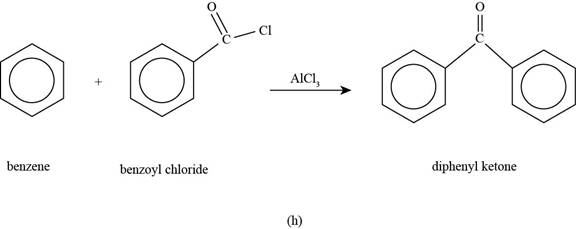
Figure
In the above reaction, benzene reacts with benzoyl chloride in the presence of
(i)
To determine: The major product that is formed by reaction of benzene with iodine molecule in the presence of
Interpretation: The major product that is formed by reaction of benzene with iodine molecule in the presence of
Concept introduction: The reaction that includes the addition of one or more than one halogen atoms in a compound is known as halogenation reaction.
(i)
Answer to Problem 17.50SP
The major product that is formed by reaction of benzene with iodine molecule in the presence of
Explanation of Solution
The major product that is formed by reaction of benzene with iodine molecule in the presence of

Figure
In the above halogenations reaction, benzene reacts with iodine molecule in the presence of
(j)
To determine: The major product that is formed by reaction of benzene with nitric acid and sulphuric acid.
Interpretation: The major product that is formed by reaction of benzene with nitric acid and sulphuric acid is to be predicted.
Concept introduction: The reaction that involves the addition of a nitro group on an alkyl or an aromatic compound in the presence of concentrated nitric acid and sulphuric acid is known as nitration reaction.
(j)
Answer to Problem 17.50SP
The major product that is formed by reaction of benzene with nitric acid and sulphuric acid is shown as follows.
Explanation of Solution
The major product that is formed by reaction of benzene benzene with nitric acid and sulphuric acid is shown in Figure
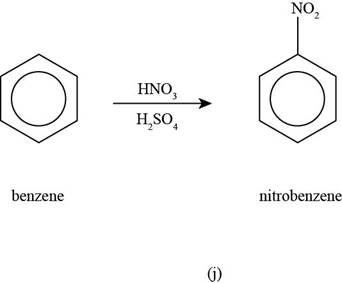
Figure
In the above nitration reaction, benzene reacts with concentrated nitric acid and sulphuric acid that forms nitrobenzene as the desired product.
(k)
To determine: The major product that is formed by reaction of benzene with carbon monoxide in the presence of
Interpretation: The major product that is formed by reaction of benzene with carbon monoxide in the presence of
Concept introduction: The synthesis in which
(k)
Answer to Problem 17.50SP
The major product that is formed by reaction of benzene with carbon monoxide in the presence of
Explanation of Solution
The major product that is formed by reaction of benzene with carbon monoxide in the presence of

Figure
In the above reaction, benzene reacts with benzoyl carbon monoxide in the presence of
(l)
To determine: The major product that is formed by reaction of benzene with
Interpretation: The major product that is formed by reaction of benzene with
Concept introduction: Friedel-Crafts acylation permits the synthesis of acylated products by the reaction of arenes with acyl chlorides in the presence of
(l)
Answer to Problem 17.50SP
The major product that is formed by reaction of benzene with
Explanation of Solution
The major product that is formed by reaction benzene with

Figure
In the above reaction, benzene reacts with
Want to see more full solutions like this?
Chapter 17 Solutions
Organic Chemistry&mod Mstgchem Ac Pkg
- Alcohols are important for organic synthesis, especially in situations involving alkenes. The alcohol might be the desired product, or the OH group might be transformed into another functional group via halogenation, oxidation, or perhaps conversion to a sulfonic ester derivative. Formation of an alcohol from an alkene is particularly powerful because conditions can be chosen to produce either the Markovnikov or non-Markovnikov product from an unsymmetrical alkene. Using your reaction roadmap as a guide, show how to convert 4-methyl-1-pentene into 5-methylhexanenitrile. You must use 4-methyl-1-pentene and sodium cyanide as the source of all carbon atoms in the target molecule. Show all reagents needed and all molecules synthesized along the way.arrow_forwardWhen you react ammonia with a halogenated Alkane will you get only one organic product? Why or why notarrow_forwardA mixture of 0.10 mol benzene and 0.10 mol 1,4-dimethyl benzene was allowed to react with 0.10 mol nitronium ion until all the nitronium ion was gone. Two products were formed: 0.002 mol of one and 0.098 mol of the other. Draw the structures of the major and minor products.arrow_forward
- what is the compound that most easily reacts with bromine in addition? a) CH4 b) C2H2 c) C3H8 d) C4H10arrow_forwardA lab technician planned to synthesize 2-bromopentane using 2-pentanol, heat, and HBr. However, the labtechnician did not have HBr in the lab. What other reagent(s) can the technician use to synthesize 2-bromopentane using 2-pentanol as the starting material?arrow_forwardOxidation of Butanol -1 in KMnO4/H+ will produce-------------. a.Butanoic Acid b.Butanal c.Pentanoic acid d.Butene -2arrow_forward
- What would the steps be to get from the starting material to the product?arrow_forwardi need help filling out the following SN2 reactions with appopiate reactants, products, or reagents,arrow_forwardTunicates are marine animals that are called "sea squirts" because when they are taken out of water, they tend to contract and expel seawater. Lepadiformine is a cytotoxic agent (toxic to cells) isolated from a marine tunicate. During a recent synthesis of lepadiformine, the investigators observed the formation of an interesting by-product (3) while treating diol 1 with a reagent similar in function to PBr3 (J. Org. Chem. 2012, 77, 3390–3400):arrow_forward
- Find the product formed by writing down the mechanism of the reaction.arrow_forwardWhen 2-bromo-2,3-dimethylbutane reacts with a strong base, two alkenes (2,3-dimethyl-1-butene and 2,3-dimethyl-2-butene) are formed. a. Which of the bases (A, B, C, or D) would form the highest percentage of the 1-alkene? b. Which would give the highest percentage of the 2-alkene?arrow_forwardPossible route of synthesis to this reaction. Example: 1) Br2; H2O 2) H2SO4, H2Oarrow_forward
 Organic ChemistryChemistryISBN:9781305580350Author:William H. Brown, Brent L. Iverson, Eric Anslyn, Christopher S. FootePublisher:Cengage Learning
Organic ChemistryChemistryISBN:9781305580350Author:William H. Brown, Brent L. Iverson, Eric Anslyn, Christopher S. FootePublisher:Cengage Learning
